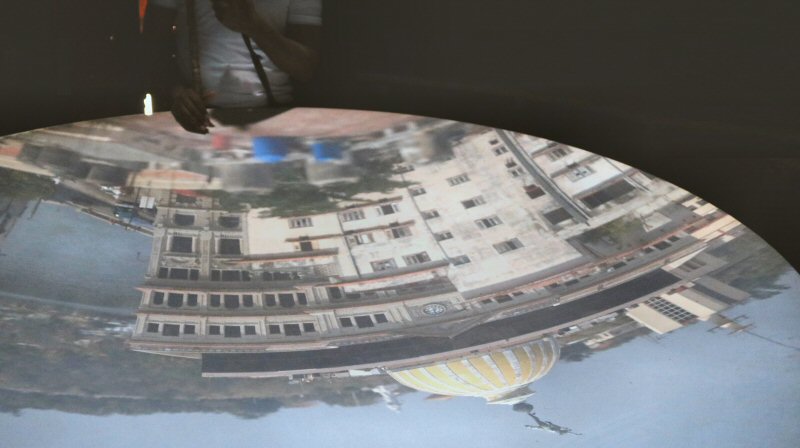



The Cámara Oscura is located at the top
of the seven-storey Edificio Gómez Vila at the northeastern
corner of the Plaza Vieja, where the Mercaderes street
intersects with
the Teniente Rey street.
Although the origin of the dark
chambers is not known with certainty, the term cámara
(house) comes from Arabic language. It was introduced for
the first time by the Arab physicist and astronomer Alhacén
(Ibn-i Heysem) that is considered the father of optics for
his work and experiments with lenses, mirrors on reflection
and refraction in the first half of the 11th century. He was
aware of the way of the formation of the optical image by
the sun rays that pass through a small hole without mixing
up one with another. It was Leonarda da Vinci in 15th
century that made the first complete and illustrated
description of the operation of the camera obscura (dark
room). Furthermore, he used the principle of the camera
obscura in order to explain how the image could form in the
eye.
In 17th century Robert Hooke used concave screens in the camera obscuras to reproduce the curved shape of the retina in the eye. He also produced the first portable camera obscura in the form of a drawing table that consisted of a large wooden box with a lens at its front side. When it was directed to a landscape, its image was reflected on a glass at the top of the box, so that the image could be copied on a transparent cardboard. In the 17th century Zahn published a book about camera obscuras in that he explained the system of the model that didn´t change until the invention of photography in the 19th century.
During the
17th to 19th century camera obscuras were widely used by
topographers, painters and travelers.
The Edificio Gómez Vila was constructed for the
Ministry of Foreign Trade and it was completed in 1909. Since
2002 it is the property of the firm Phoenix. With a height
of 35 meters, it is the tallest building in Palaza Vieja.
The Cámara Oscura was inaugurated at the top of this yellow
building in 2001. It was the donation of the Provincial
Council of Cádiz to Cuba.
In the Cámara Oscura the live images are captured by
means of a periscope that is placed on a tower of about 4
meters on the top of the building and reflected on a concave
screen in the dark room. Although it seems that the visitor
is facing with the latest technology, the design of the
system is based on the works of Leonardo Da Vinci from the
15th century. The operation of the system is based on the
principles of light reflection through the use of two lenses
and a mirror located on the periscope. It is an optical
phenomenon that was discovered by the ancient Greek
philosopher Aristotle in the 4th century B.C.. He formulated
that by making a small hole at the wall of a dark room; the
entering light beam would draw the inverted image of the
outside on the opposite wall. Similar observations are found
in the texts of some Chinese philosophers from the 5th
century.
 The optical system of the Cámara
Oscura provides 30X magnification, so that the visibility
range reaches about 5 km. The screen that is mounted on a
mechanical axis, consists of a white concave screen that
measures 1.8 meters in its diameter. Its vertical movement
provides the sharpness of the image, and to some extent it
controls the color. The ambient light during the projection
contributes to obtain sharp images. Therefore, it is
recommended to visit this place better on clear, cloudless
days. The periscope is turned by a rope hanging through the
hole on the ceiling. Through a 360-degree-rotating
telescopic lens you can watch the architectural beauty of
the city and be aware of all what happens in the close
environment of the building, particularly in the Plaza Vieja.
You can capture beautiful city scenes that you are unaware
of them.
The optical system of the Cámara
Oscura provides 30X magnification, so that the visibility
range reaches about 5 km. The screen that is mounted on a
mechanical axis, consists of a white concave screen that
measures 1.8 meters in its diameter. Its vertical movement
provides the sharpness of the image, and to some extent it
controls the color. The ambient light during the projection
contributes to obtain sharp images. Therefore, it is
recommended to visit this place better on clear, cloudless
days. The periscope is turned by a rope hanging through the
hole on the ceiling. Through a 360-degree-rotating
telescopic lens you can watch the architectural beauty of
the city and be aware of all what happens in the close
environment of the building, particularly in the Plaza Vieja.
You can capture beautiful city scenes that you are unaware
of them.

The guides give information in
Spanish, English, French and Italian.
The dark room was built by the
English Sinden Optical Company, based on the design of
Leonardo Da Vinci from the 15th century. There are 64 known
dark rooms all over the world that still operate, but most
of them are scattered in the cities of the United Kingdom,
Spain, Portugal and the United States. The Cámara Oscura of
Havana is unique throughout Latin America and the Caribbean.
On the back of the Cámara Oscura
there is a terrace that provides a wonderful view of the
Plaza Vieja and its surrounding. From there you can take
very beautiful photos of the Old Square, the bay and even
the Capitol.